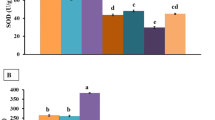Abstract.
Gallium arsenide (GaAs), a group III-VA intermetallic semiconductor, possesses superior electronic and optical properties and has a wide application in the electronics industry. Exposure to GaAs in the semiconductor industry is a potential occupational hazard because cleaning and slicing GaAs ingots to yield the desired wafer could generate GaAs particles. The ability of GaAs to induce oxidative stress has not yet been reported. The present study reports the role of oxidative stress in GaAs-induced haematological and liver disorders and its possible reversal overturn by administration of meso-2,3-dimercaptosuccinic acid (DMSA) and one of its analogue, monoisoamyl DMSA (MiADMSA), either individually or in combination with oxalic acid. While DMSA and MiADMSA are potential arsenic chelators, oxalic acid is reported to be an effective gallium chelator. Male rats were exposed to 10 mg/kg GaAs orally, 5 days a week for 8 weeks. GaAs exposure was then stopped and rats were given a 0.5 mmol/kg dose of succimers (DMSA or MiADMSA), oxalic acid or a combination of the two, intraperitoneally once daily for 5 consecutive days. We found a significant fall in blood δ-aminolevulinic acid dehydratase (ALAD) activity and blood glutathione (GSH) level, and an increased urinary excretion of δ-aminolevulinic acid (ALA) and an increased malondialdehyde (MDA) level in erythrocytes of rats exposed to GaAs. Hepatic GSH levels decreased, whereas there was an increase in GSSG and MDA levels. The results suggest a role of oxidative stress in GaAs-induced haematological and hepatic damage. Administration of DMSA and MiADMSA produced effective recovery in most of the above variables. However, a greater effectiveness of the chelation treatment (i.e. removal of both gallium and arsenic from body organs) could be achieved by combined administration of succimer (DMSA) with oxalic acid since, after MiADMSA administration, a marked loss of essential metals (copper and zinc) is of concern.
Similar content being viewed by others
Author information
Authors and Affiliations
Additional information
Electronic Publication
Rights and permissions
About this article
Cite this article
Flora, S.J., Kannan, G.M., Pant, B.P. et al. Combined administration of oxalic acid, succimer and its analogue for the reversal of gallium arsenide-induced oxidative stress in rats. Arch Toxicol 76, 269–276 (2002). https://doi.org/10.1007/s00204-002-0347-5
Received:
Accepted:
Issue Date:
DOI: https://doi.org/10.1007/s00204-002-0347-5




